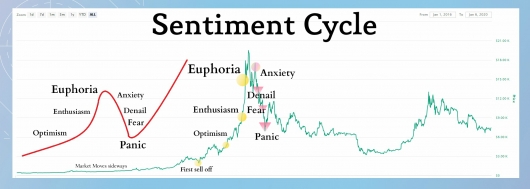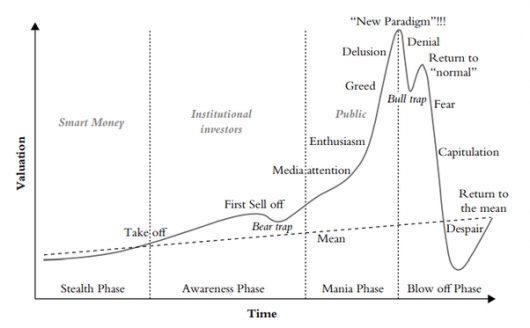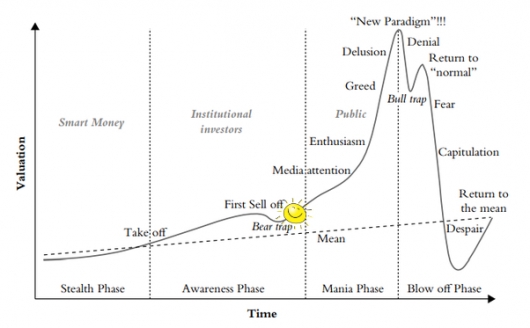Crypto trading / Is this the beginning of the end of cryptocurrency mania?
No, it is the end of the beginning.
Depending on what survey you believe, less than 8% of people hold any cryptocurrency. Perhaps as little as 2% of the entire world. The most popular reason for investing in the “Internet coin” was the “technology that would change the world” and belief that investment will have high value: “long-term money storage means, like gold or silver”.
And yet, central banks talk openly about creating their own crypto. JP Morgan, Ripple, IBM, and Ernst & Young use crypto in their businesses. Microsoft is developing on bitcoin. Wall Street continues to create new crypto-based financial products. Most crypto businesses and projects are either growing or have enough money to weather further drops in prices.
Germany gave banks permission to hold crypto for clients. China and the UAE have blockchain mandates. Bitcoin went up 100% last year.
Of course, this could simply be the natural evolution of cryptocurrency. It certainly doesn’t mean people are going to suddenly go bonkers and mortgage their houses and sell their children to buy bitcoin.
Not yet, at least.
Mania comes next

As you can see in the Sentiment Cycle, we have started approaching the end of the first great sell-off.
Speculative bubbles, like cryptocurrency, have a certain pattern to them. You see this in every asset bubble ever. Robert Shiller won a Nobel Prize for this discovery.
Here’s what it looks like:

(Anatomy of a bubble. Source.)
This pattern repeats all the time, on small and long time frames. A certain approach to market cycles, called the Elliott Wave Theory, offers a similar pattern.
Basically, you have a run-up followed by a sell-off. This run-up comes from well-connected insiders (“smart money”) and professional speculators (“institutional investors”). At the time, it seems like the end. “Nice idea, didn’t work out” or “it was too early” or “fun while it lasted.” Prices rise relatively quickly, then fall relatively quickly, but not back down to where they started.
During this time, your average person—” the mainstream”—becomes aware of something’s going on. But the most don’t get into it, and those that did mostly sell out or give up.
After that first sell-off, prices rebound, eventually going higher than the original run-up. Prices continue going up until it seems like the new normal.
Bitcoin has had two such cycles, one from its creation to 2013, the other now. In 2014, bitcoin crashed and many people gave up. Sold their miners, threw away their hard drives, tossed their private keys, and created altcoins. It was the end of a near five-year bubble.
And then the bubble grew again, starting at the end of 2016. At that point, smart money started accumulating again. Then 2017 started the ICO boom, bringing institutional investors and a new run-up that peaked at 20k before selling off again.
What comes next?
Mania.
On the chart below, we’re the smiley face.

How do I know this?
I don’t. I simply follow patterns. Bubbles follow predictable patterns. “Mania” is a natural progression of that pattern.
Especially if bitcoin’s price keeps doing this:
“But patterns stop! The past does not predict the future.”
True.
BUT.
Generally, when you spot a pattern in anything, you should assume that pattern will continue unless there’s some fact or data suggesting otherwise. You do this with almost everything else that exists. Your life depends on it—as does every computer program, machine, medical device, drug, house, and government.
Bitcoin seems to crash all the time because its pattern is different than stocks (even if the charts look the same). A 40% drop in stocks would trigger financial ruin. A 40% drop in bitcoin just means its Monday. If the S&P 500 doubled over a year, people would be selling everything to throw some money into an ETF. When bitcoin doubles in a year, people get disappointed. Stocks rise 20% 3 out of 4 years, drop 10% 1 out of 4 years. Bitcoin could do those numbers in a single day—to the upside and the downside. Stop comparing the stock market to bitcoin.
It’s possible bitcoin mania already ended and what we’re seeing now is simply the continued natural, organic growth of a novel technology. I doubt it, but you can make the case (I make a different case in this post).
Please comment with facts and data that suggest some other outcome.
(NOTE the argument “nobody uses it” doesn’t count. “Nobody” has used bitcoin forever, and yet we’ve had two manias already and the price keeps going up. Therefore “nobody uses bitcoin” cannot prove “bitcoin mania is ending” even if you believe both statements are true. Find another reason to suggest bitcoin mania is ending.)
Why Do People Use Cryptocurrencies?
Some believe it is a way to become rich, others note the overall phenomenon of convenience. These reasons help to guess how many people use cryptocurrency:
- Swiftness. Operations in BTC are conducted much faster than bank transactions. The transactions with “zero-confirmation” run instantly. The acceptant takes all transfer risks, which is unapproved by the blocks’ chain. Or it can take about ten minutes if the acceptant waits for confirmation;
- It is cheap. One can easily doubt the previous statement by saying that credit card transactions do not take much time. Yes, it is true. But acceptant pays an additional price for this privilege. The network transactions do not stipulate for fees, and if they do, the fees are minimal;
- The government cannot take it away. In March, the year 2013 Cyprus government tried to take away all uninsured deposits upper than $100 000. This cannot happen to Bitcoin, as a currency is decentralized and depends on the Internet without controlling authorities. Banks cannot take it away as well;
- Chargebacks are absent. When Bitcoins are sent, a return is impossible. A sender cannot take them back without the acceptor’s permission;
- No one can steal personal data. BTC transactions use two encryption keys: public and private. The public one is available for everyone (technically, it is an address of your wallet) but only an owner has the private key. When coins are sent somewhere, you “sign” the transaction with a mathematical function applied to your key;
- No inflation. The main problem with fiat currency is its unlimited amount. It leads to currency value decreasing. The Bitcoin is developed with a limited coin quantity. The initial idea implied that it was impossible to mine for more than 21 million. It means that as soon as these numbers are reached, the further creation is impossible. Deflation takes place. The goods and services prices get lower and the coin value increases in the Bitcoin universe.
How Many People Will Own CryptoCurrency in the Future?
Predicting the user number is pretty difficult. Several factors allow assuming the online money owner's number will rise dramatically. The fact that banks and even countries try joining cryptocurrency fashion only proves their stability.
The most convenient way to know the actual number of how many people use bitcoin is by watching the exchange sources statistics. But no evidence exists that the participant number involved in the rush will grow dramatically.
Rent a profitable trading bot
Top 3 traders
Top : 1
ma****@gmail.comAvg Trade time : 6 hours Opened deals : 5 Total deals : 284
Last update: 3 years ago
Top : 2
sa****@inbox.lvAvg Trade time : 6 hours Opened deals : 11 Total deals : 459
Last update: 3 years ago
Top : 3
as****@gmail.comAvg Trade time : 5 hours Opened deals : 3 Total deals : 332
Last update: 4 years ago